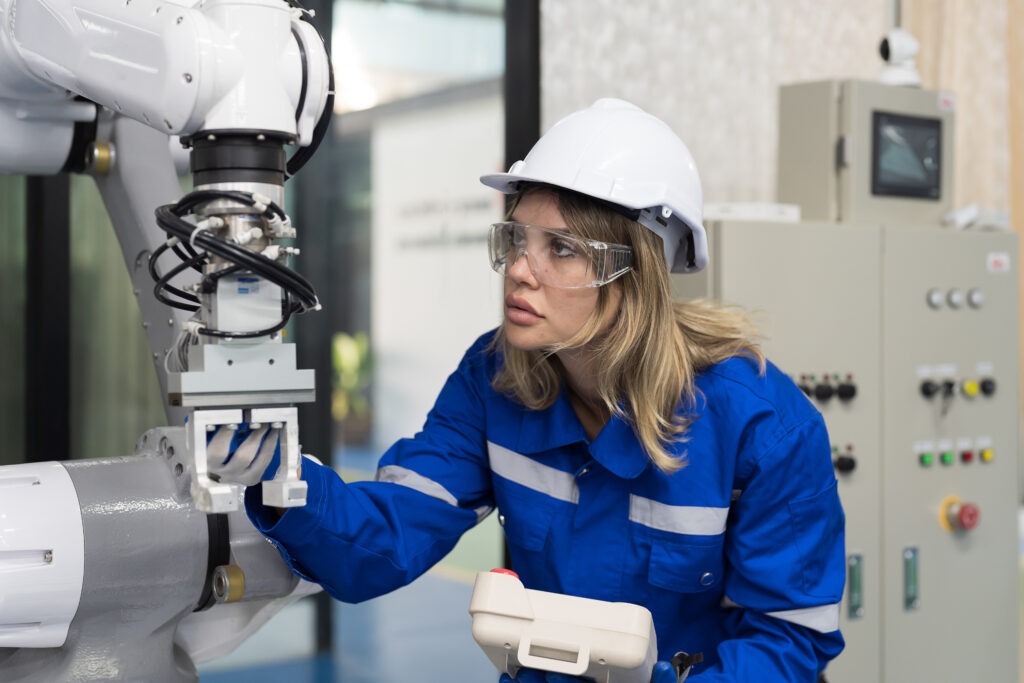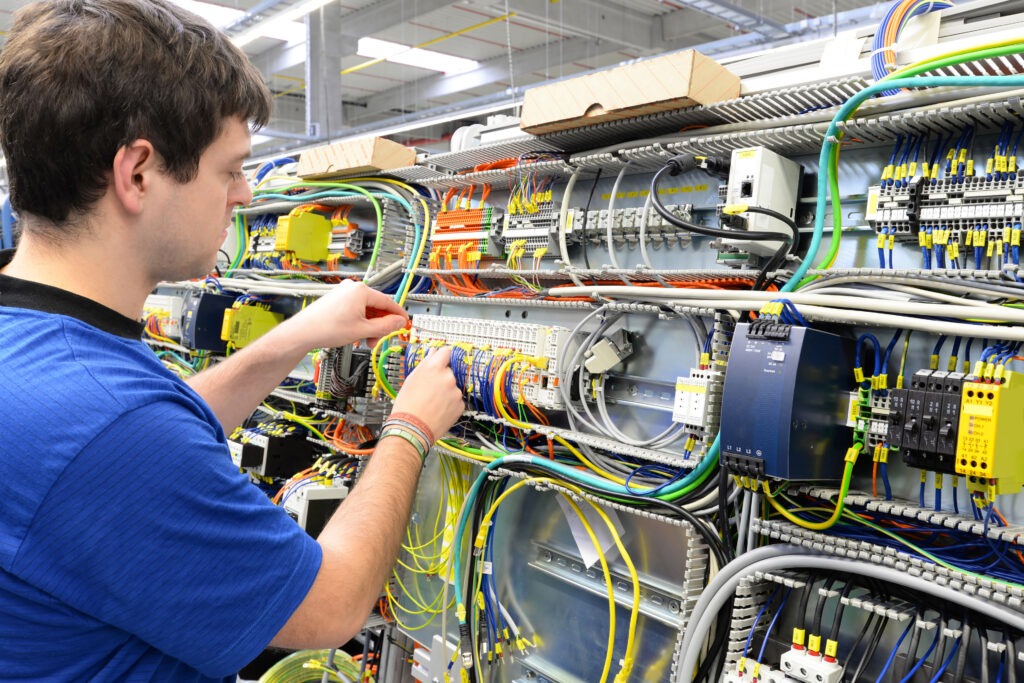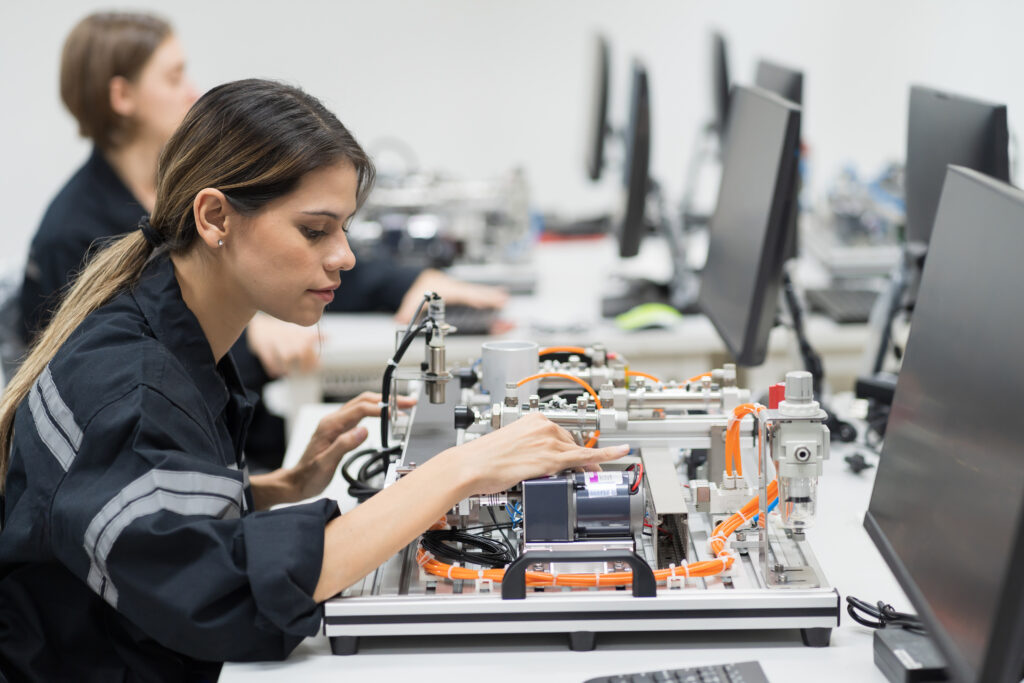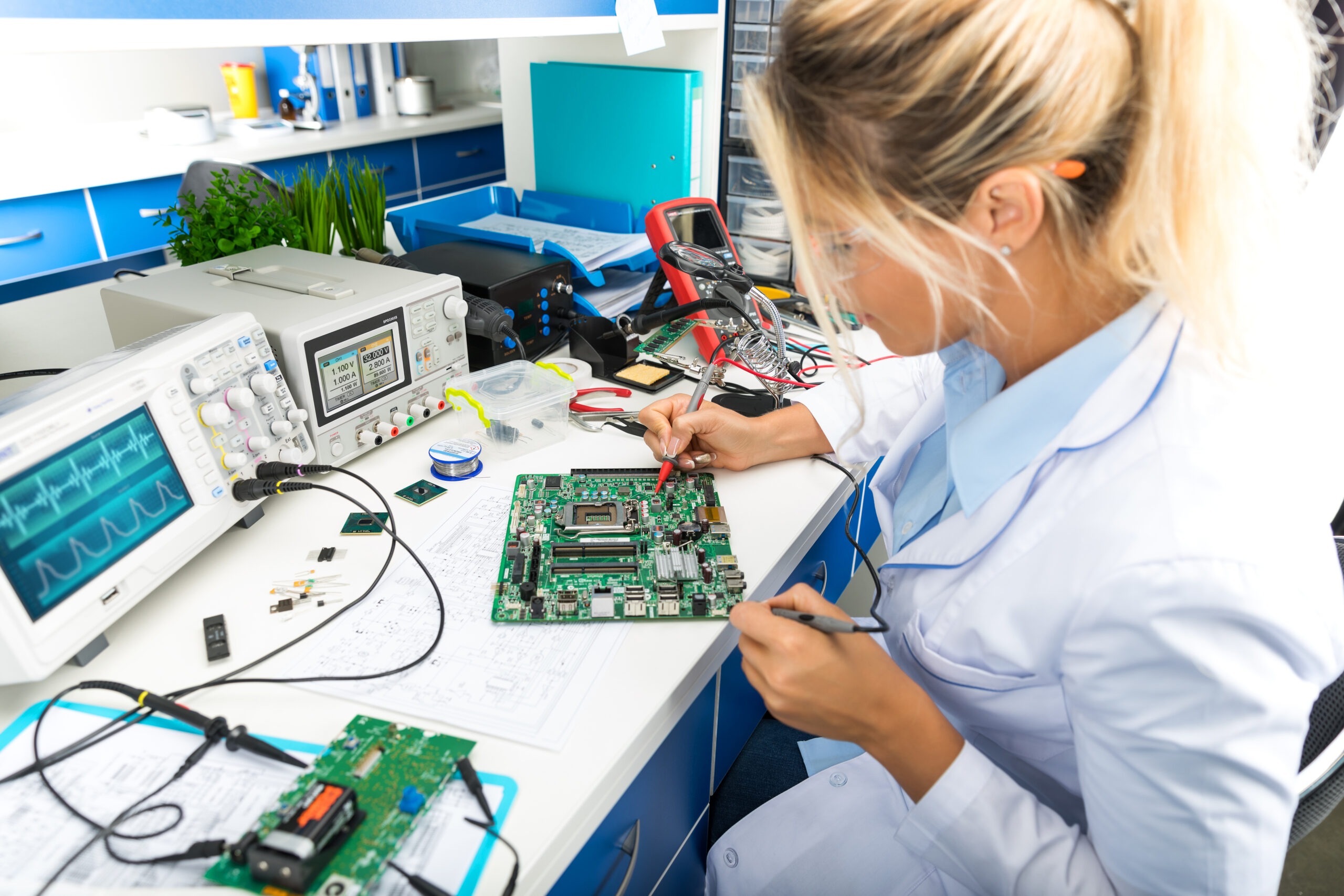Mechatronics technician, microtechnologist, electrical systems fitter, IT systems electrician
In an increasingly technological world, specialised professionals play a crucial role in the development, maintenance and optimisation of modern systems and facilities. Professions such as mechatronics engineer, microtechnologist, electrical system fitter and IT systems electricians reflect this evolving landscape. Below, we outline the key responsibilities, training requirements, and career prospects of these dynamic professions.
Table of contents
Estimated reading time: 20 minutes
What does a mechatronics engineer do?
When you hear the word "mechatronics engineer" as a layman, the last thing you would think of is an electricians or electronics technician. However, mechatronics engineers actually combine electrical, electronic and mechanical systems, so the term makes perfect sense.
Mechatronics engineers work with robots, mechanical, electrical and electronic assemblies and components that together form an entire system. They check the individual components. They assemble them and use them to create the overall systems and equipment. Once these have been completed, the mechatronics engineers programme the control systems or install the software and put the systems into operation.
Mechatronics engineers carry out their tasks based on detailed design drawings and circuit diagrams. They check whether the systems have been set up correctly in accordance with the regulations and whether they fulfil the safety requirements. They then hand over the systems to the customer. They also repair and maintain the systems whenever necessary.
Which digitalisation fields are linked to mechatronics?
Digitalisation is creating an exciting field of application for mechatronics engineers in 3D printing. The main aim here is to make systems for additive manufacturing more efficient.
- The same applies to Auto-ID systems. Components must be installed and measuring points created for automatic identification. These must be monitored and then the parts that need to be repaired or replaced must be identified before a fault occurs.
- It is also the task of mechatronics engineers to configure IoT platforms so that they can interact seamlessly with the production systems of the respective company. They are also responsible for machine-to-machine communication.
- Mechatronics engineers also define the interfaces for machine systems -which are digitally networked. This enables MDC, or machine data acquisition, which allows the production and performance data of the machines to be recorded. Among other things, this also helps with predictive maintenance, which also falls within the remit of mechatronics engineers. This prevents breakdowns by ruling out malfunctions.
- In addition, mechatronics engineers are active in the field of sensor technology. They install sensors in mechatronic systems or replace them if necessary. They also ensure the correct calibration.
- They are also involved when it comes to networked production systems where the individual production systems are interconnected to form a complete system. Finally, there is the wearable technology part of the work of mechatronics engineers. They use data goggles to monitor robot systems.
- Mechatronics engineers can also be found in the production of vehicles . As a mechatronics technician for motor vehicles, they are involved in the production of cars or as a two-wheeler mechatronics technician for motorbikes and are responsible for the co-operation between electronics and mechanics.

What is a microtechnologist?
A microtechnologist is responsible for small and tiny chips. These can be divided into cars, computers, hearing aids and smartphones . Here, the microtechnologist is responsible for ensuring that these small chips, which are often less than 1 cm in size, can perform their work as the computing centre of a system.
However, this also means that very special demands are placed on a microtechnologist. This includes being able to concentrate for long periods of time and having steady hands to work with these small chips.
What training do you need to become a microtechnologist?
There are two different focal points for training, which are microsystems technology and semiconductor technology. The latter is practically concerned with installing the smallest chips, which involves drilling tiny holes and etching the finest grooves into small discs. The smallest metal contacts are also attached here and micro-coils are produced using chemical processes.
In microtechnology it's all about the development of microsystems. Such systems are needed, for example, to trigger certain actions in certain situations, such as the sensor for an airbag. This also requires precise connections with super-thin wires.
In their day-to-day work, microtechnologists spend most of their time in a so-called clean room. This is a room in which there is dust-free air that makes it possible to work with the smallest components. Microtechnologies place chips with millimetre precision and create tiny connections that are essential for communication.
It is only possible to work with such small microchips in a clean room. Even a small speck of dust is capable of damaging such a small chip or destroying the entire work output of a day. Accordingly, it is also important to constantly ensure that the cleanroom is indeed extremely clean, which is why regular inspections are carried out.
There are also dedicated production systems for working with these tiny components. These have to be set up and monitored. This also falls within the remit of a microtechnologist. They have to ensure that the systems are functioning properly and that the processes run smoothly.
What fields of application are there for microtechnologists?
It stands to reason that microtechnologists are primarily employed in companies that produce computer chips, electronic components or electromedical devices. They are also needed in companies that are dedicated to research in this field.
The training takes place partly in a company and partly at vocational school. In the company, the main focus is on familiarising yourself with the technical documentation. Microtechnologists must be able to read and apply them. They must also be able to create their own sketches for technical documents. They also have to learn how to work in a clean room. This includes knowledge of the necessary framework conditions and the operation of the relevant production equipment. The activities from the respective specialisation are also taught.
The vocational school supports the training in the company with job-specific subjects. These include the processes involved in signal processing as well as basic knowledge of basic electrical parameters. In addition, there are the theories that are needed for everyday work. The apprenticeship generally lasts 3 years. However, this can be shortened to 2 or 2.5 years. The IHK is responsible for this.
What is the salary of a microtechnologist?
Your salary in the electrician apprenticeship programme is between €980 and €1,200 for the first year. In the second year, you will receive between €1,000 and €1,200 and in the third year you can expect between €1,100 and €1,300. However, the exact amount depends on the region and the applicable collective agreements.
What are the requirements for microtechnologist training?
Training as a microtechnologist is just right for you if you:
- Like to keep things clean and neat
- Are very careful at work
- You have very good eyesight
- Modern technology is interesting to you
Once you have successfully completed your training, it's all about keeping your skills and knowledge up to date. This is particularly important given the rapid progress in the fields of nano, micro, information, communication and semiconductor technology. In addition, there are constantly new standards, test regulations and safety regulations that must be observed when using control technology, control systems and measuring devices. This requires regular training to keep up to date.
If, on the other hand, you really want to make a career for yourself, there are a number of career development paths open to you. These are mainly in the fields of mechatronics and PCB technology. You can then become a state-certified technician in both. If you are interested, a degree programme is also an option. These study programmes are worthwhile:
- Microsystems technology
- Microtechnology
- Sensor technology
- Nanoscience
The future prospects for microtechnology work are very good, as this form of technology is increasingly needed everywhere. This also includes developments in the field of environmental protection and sustainability. Your work can help ensure more efficient use of energy. Quite simply, you will be helping to develop microchips that use less energy. In addition, you are always in demand in microchip production.

What is an electrical system fitter?
Electrical system fitters are tasked with manufacturing electrical systems, installing them and inspecting, maintaining and troubleshooting existing systems. This primarily concerns all the technology required for the supply of energy. This includes the switching and control of the systems. They also take care of signalling technology and lighting.
A typical example of the work of electrical system fitters is the networking of high-voltage lines. This ranges from power stations to connecting the various private homes and public buildings to the overall energy network. For electrical system fitters, this means that they also have to travel to assemble, install and repair various supply systems. These systems cover wide areas and they have to work independently and on behalf of various customers.
In addition to the manual work, planning skills are also required. As the work extends over large areas, it is not enough to simply get started. Instead, clear assembly and wiring diagrams are needed for orientation - and good coordination with colleagues and other teams is also essential.
What manual tasks does an electrical systems fitter perform?
The manual work then involves moulding and joining metals, wires and insulation. To do this, electrical system fitters learn how to handle tools very precisely and how to drill and file accurately:
- Firstly, the various workpieces required for the overall network are put together. These are then assembled in the appropriate place and connected to the network.
- This is followed by assemblies and electrical parts that are important for the network.
- Once the individual components are finished and checked, they are connected to form a complete system.
This type of construction and assembly work is also essential for the future. This is the only way to ensure a sufficient supply of energy for all households, industry and public buildings. This means that the profession of electrical installation technician is definitely future-proof.
In addition to setting up the supply networks, the existing areas are also kept in operation. To this end, they must be regularly inspected and maintained. Protection measurements must also be carried out to ensure that the systems are operating within the prescribed parameters. The measurement data is then checked against the circuit diagrams and the existing calculation tables. This makes it possible to detect defects before deviations become too significant. Worn out parts can then be replaced or repairs carried out in time to ensure uninterrupted operation.
What are the requirements to become an electrical systems fitter?
Anyone who wants to become an electrical system fitter, should enjoy technology and working with their hands. He should also be able to connect small individual parts in such a way that they become assemblies that can then be assembled into complete systems.
Also mathematical skills and basic knowledge of physics are required - they help with reading and creating circuit diagrams. The latter also requires a certain talent for drawing. Good hand-eye coordination is also essential for the assembly of small parts.
You should also be willing to constantly change your place of work whenever a new client is waiting with a new challenge. This also requires good communication skills and flexibility during the planning stage.
In addition, electrical system fitters often work in shift work. Accordingly, there should also be a corresponding willingness here, which also requires a little flexibility within the family.
Another prerequisite for starting training as an electrical systems fitter is at least a a lower secondary education qualification. You should also be a team player and work cleanly and conscientiously.
How much does an electrical systems fitter earn?
Once they have completed their training, many start with a gross salary of around € 2,800 per month. During the apprenticeship, the gross salary is around €1,190 per month. However, the exact amount depends on the training company and your region.
How does training as an electrical systems fitter work?
The apprenticeship itself lasts 3 years and takes place simultaneously in a training company and a vocational school. An intermediate examination must be taken after the 2nd year of training. The final examination takes place at the end of the 3rd year of training.
The training includes the creation of circuit diagrams and the assembly of systems according to these diagrams. You will also learn how to create components from workpieces and how to maintain electrotechnical systems. You will also learn how to lay cables and lines and how to set up and wire control cabinets.
You’ll also be taught how to solder and troubleshoot faults and malfunctions within a system. At the same time, you will learn how to correctly record and document faults. The programme also includes the installation of switchgear, the installation of lighting systems and the assembly of enclosures. And, of course, you will also learn how to wire the individual assemblies correctly.
Where can electrical systems fitters find work?
After the apprenticeship, there are various opportunities of work in the industry or trade as an electrical systems fitter . This includes the technical business administrator programme, in which you take on commercial tasks and technical work. You will also plan and organise the work of an entire team.
Another path is the industrial master craftsman in the field of electrical engineering. This means that you are primarily responsible for the quality of the products and you also take on management tasks and personnel planning duties. It is also possible to study with a university entrance qualification. You can specialise in electrical engineering and information technology.

Electronics technician for information and telecommunication systems
After 3 years of training, information and telecommunication electronics technicians deal with information and telecommunication technology systems. This is also in the name and is therefore no surprise. In detail, however, this means that they install the devices for this technology, assemble the components and connect them to a network. They implement the best possible solutions for their customers and also customise hardware and software.
What are the tasks of an IT systems electronics technician?
- For existing systems IT systems electricians analyse and they find and eliminate faults if necessary. They also detect faults and improve the efficiency of networks. They mainly work in companies that offer products, services or both in the field of information and communication technology.
- For larger projects IT system electronics engineers advise customers on how to use the IT devices and systems. You install them, which also includes connecting them to the power supply. Then you configure them.
- IT system electronics technicians also set up networks and they install wireless systems for information transmission. They also position the devices in such a way that ergonomic requirements are met.
- During daily operations in companies, they carry out maintenance work on the devices and systems. To do this, they use diagnostic systems to find faults and then rectify them. They also train future users on the systems and their operation, and handle the invoicing of their services.
As part of these services, IT system electronics technicians must also pay attention to IT security and data protection. They also need to have the personal and social skills to be able to work in a team and with customers and their wishes.
What do training and final exams look like in IT system electronics?
The final examination for the training programme consists of two parts, which are carried out at different times. The first part is a written examination. This lasts 90 minutes and takes place in the fourth half-year of training. It makes up twenty per cent of the overall result of the final examination.
The second part takes place directly at the end of the training period. Three written parts of the examination are taken, each representing 10 per cent of the overall result. In addition, there is project work in the company, which is weighted at 50 per cent of the overall result.
Project work in operations involves the creation, expansion or modification of IT systems and the associated infrastructure. This work also consists of 2 parts. The first part takes a maximum of 40 hours. This involves carrying out a project and creating documentation for it.
In the second part, the project work is presented. An examination board is convened for this purpose, and the presentation is followed by a technical discussion. Both the presentation and the discussion last 15 minutes each.
What is a technical system planner?
A technical system planner creates the construction and assembly plans required for a system. These must contain all the pipes, ventilation systems and technical components that are required. This is important when constructing a new building, for example. To do this, the technical system planner collates all the data and information, uses it to plan the relevant elements of the system and uses it to create a production plan on the appropriate scale.
The documents and drawings created serve as the basis for the fitters who later install and assemble the systems on site. There are several areas of specialisation. These include steel and metal construction technology, supply and equipment technology and electrotechnical systems.
How does training as a technical system planner work?
The apprenticeship lasts 3.5 years. Prerequisites include a vocational qualification with a lower secondary school certificate, an intermediate school leaving certificate, or a high school diploma.
After the apprenticeship, important tasks can be taken on. These revolve around the preparation of drawings and technical documents for the systems from the chosen specialisation.
The drawings must be designed to meet the client's specifications, fulfil all safety requirements and enable a functional system. Computers and design software are used for this purpose. These allow the creation of documentation and drawings to the correct scale and in a shorter time. This includes all the components and systems required for the overall installation.
This is followed by coordination . It is necessary to calculate which material, in what quantity, which components, in what number and in what order must be provided or manufactured. In addition, calculations and information are needed for the realisation of the planning. This realisation must also be coordinated and subsequently checked.
What are the job requirements for technical system planners?
As a technical system planner, you should have a number of important qualities. It starts with a very good spatial imagination. This will enable you to plan the systems and reproduce them in the correct scale in the drawings. You also need a good understanding of technology and maths to be able to carry out all calculations correctly.
What is included in the technical system planner training?
The training programme covers all the important areas required for working as a technical system planner:
- Firstly, this includes the use of information and communication technologies so that you can also easily prepare the corresponding documentation at the end. You will also learn how to plan and organise work so that you can monitor and coordinate its implementation. Quality assurance measures are also part of the training, enabling you to contribute to the successful implementation of projects.
- Further training content covers customer orientation. Ultimately, the system must fulfil the client's specifications. Therefore, confident handling of the system, a good understanding of the requirements and clear communication about the progress of the work are crucial.
- The training also includes content on differentiating between materials so that the right materials can be used in planning and implementation. This is complemented by training in distinguishing between different manufacturing processes and assembly techniques. It is also essential to learn how to carry out calculations, as these form the basis for subsequent planning.
- In addition, there is a section on creating technical documents, which also includes the creation of sketches. This also includes learning how to assess assembly and joining processes. The training also includes lessons on the organisation of a company as well as labour and collective bargaining law. Rules for health and safety, environmental protection and sustainability are also taught. Finally, the best way to proceed in the digitalised world of work is also taught.
What specialisations exist for technical system planners?
Further training content depends on the chosen specialisation. Elements of the basic training are expanded and tailored to the specific focus area – for example, through precise handling of documentation relevant to that specialisation.
The training programme has a final examination, which is given in two parts. The first part is carried out at the end of the second year of training and the second part takes place at the end of the entire training programme. Afterwards, there are a number of career opportunities. These include a master craftsman's certificate or a career in management by training as a business administrator.
Related topics:




